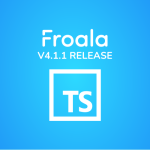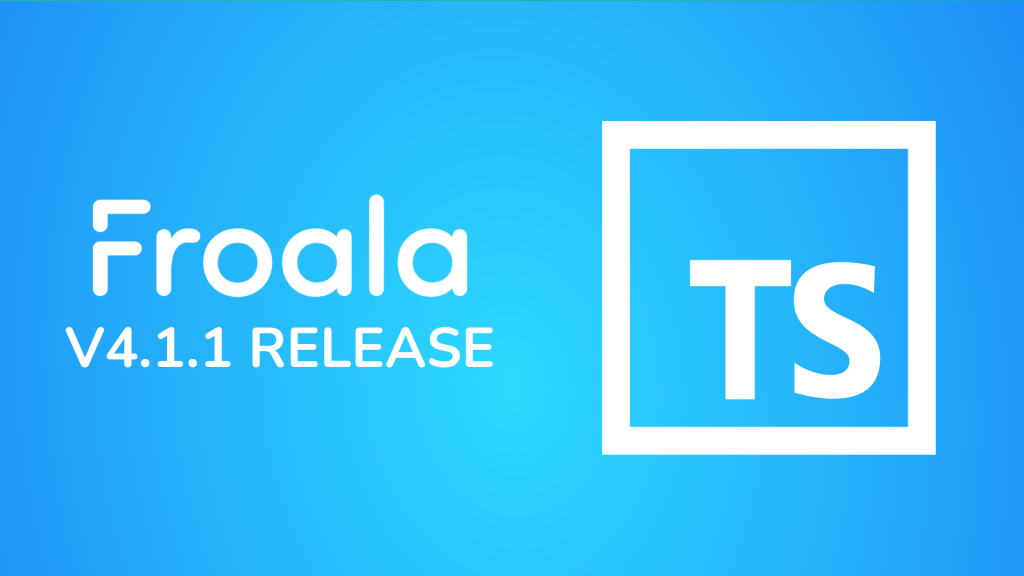Why Froala 4.1.1 is Essential: A Quick Recap
- Posted on
- By Carl Cruz
- In General, New Releases
Table of contents
- A Quick Flashback to Froala 4.1 and TypeScript
- What’s New in Froala 4.1.1?
- TypeScript is Now Even Cooler
- More Goodies for Angular Coders
- Fixing TypeScript Definitions
- Extra Content: Why this is a big deal
- Easy-to-Add Features with Modular Design
- Handle Tasks that Take Time Smoothly with Asynchronous Support
- Keep Up with Real-Time Changes Using Observables
- Why You Should Update Now
- Time to Wrap It Up

Hello developers! A while back, we unveiled Froala V4.1.1, an iteration that succeeded our much-acclaimed V4.1 release. In case you missed out, this update came with a host of improvements designed to give you an unparalleled coding experience. Today, we’re revisiting the groundbreaking features of this update, paying special attention to TypeScript and Angular. Let’s dive in!
A Quick Flashback to Froala 4.1 and TypeScript
Froala 4.1 made a big move by supporting TypeScript. Why is that cool? TypeScript makes coding easier and faster. Here’s how:
- Smart Tips: TypeScript is like a smart buddy who helps you code. It gives you hints that can help you avoid mistakes.
- Error-Checking: TypeScript checks your code while you’re writing it, helping you catch errors before they become big problems.
- Better Auto-complete: This isn’t just regular auto-complete. TypeScript’s suggestions are really on point, which makes finding code easier.
But wait, not everything was perfect. People who used Froala with Angular had some issues. That’s where the new update, Froala 4.1.1, comes in to fix those problems.
What’s New in Froala 4.1.1?
TypeScript is Now Even Cooler
First, let’s talk about TypeScript again. In this new 4.1.1 update, TypeScript support is upgraded, and it’s extra helpful if you’re using Angular. Ever run into issues like wrong definitions or missing bits in the index.d.ts file? The 4.1.1 update fixes those problems. That means Froala and Angular’s TypeScript get along really well now. It’s a smooth ride!
More Goodies for Angular Coders
Moving on, if you’re an Angular developer, you’re in for a treat. The 4.1.1 update makes dealing with toolbar buttons a breeze. To get this new feature, all you need to do is add Froala’s plugin scripts to your app.module.ts file. So, it’s gotten a lot easier and more flexible to use.
import 'froala-editor/js/plugins/align.min.js';
You can activate additional buttons like align right, align left, center, and justify. If you want the full package, use this import statement:
import 'froala-editor/js/plugins.pkgd.min.js';
With 4.1.1, you now have the power to tweak the editor’s toolbar using the toolbarButtons API option. By setting this option, you can specify which toolbar buttons appear and where. Here’s an example:
<div [froalaEditor]="options" [(froalaModel)]="content"></div>
Fixing TypeScript Definitions
One of the most underappreciated but vital updates in 4.1.1 was the refinement of TypeScript definitions. For example, numerous properties were added or edited:
FE.DEFAULTS
FE.DefineIcon
FE.DefineIconTemplate
FE.END_MARKER
FE.KEYCODE
FE.MARKERS
FE.PLUGINS
FE.POPUP_TEMPLATES
FE.RegisterCommand
FE.RegisterQuickInsertButton
FE.RegisterShortcut
FE.START_MARKER
If you were experiencing errors while creating custom buttons or plugins, 4.1.1 is your go-to solution.
Extra Content: Why this is a big deal
Easy-to-Add Features with Modular Design
First off, Froala 4.1.1 has a modular design. What’s that mean? It means you can pick and choose just the features you need. This is great for working with modern JavaScript frameworks like Angular, which also love modularity. For example, you can add just the pieces you need for your Froala editor, making your app quicker to load. Plus, TypeScript makes this process safer and more predictable.
Handle Tasks that Take Time Smoothly with Asynchronous Support
Next up, Froala 4.1.1 is ready for tasks that take some time to complete, like pulling in data from a website. It uses something called JavaScript Promises to make these tasks go smoothly. TypeScript adds another layer of safety here, helping you avoid mistakes when you’re handling these tasks. For example, you can set up rules for what kind of data you’re expecting, making it less likely you’ll run into errors later on.
Keep Up with Real-Time Changes Using Observables
Lastly, if you’re an Angular developer, you’ll be happy to hear about the Observables feature. Observables help you manage changes in your app in real-time. Froala 4.1.1 works really well with Angular’s Observables. You can tie them into Froala’s events, making your app more interactive and dynamic. Picture this: you can auto-save content or update your app’s look in real-time. And again, TypeScript makes this all easier and safer to manage.
Why You Should Update Now
First things first, updating to Froala Editor 4.1.1 is super important. It’s not just another regular update. Think of it as adding a turbo boost to your coding tools, especially if you’re using TypeScript or Angular. We’ve even got a step-by-step guide at the end of our original post to help you with the update.
Time to Wrap It Up
In conclusion, the 4.1.1 version isn’t just a small tweak. It’s like redoing the whole thing to make your coding life better. So if you haven’t updated yet, you really should. You’ll get to see all the cool stuff Froala Editor has to offer.
Happy coding!
Carl Cruz
Product Marketing Manager for Froala. A technical enthusiast at heart.
-
Hide Show







No comment yet, add your voice below!